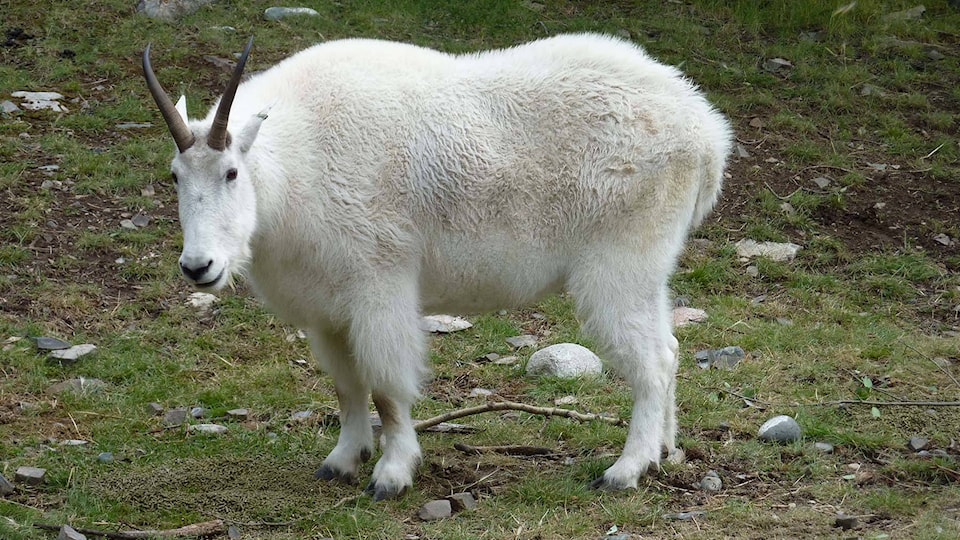The Ministry of Forestry, Lands, and Natural Resource Operations and Rural Development (FLNRO) is currently working on a plan to protect mountain goat habitat in the Bulkley region.
Ecosystem biologist in the Skeena Region with FLNRO Len Vanderstar, and Sean Sharpe, an environmental consultant and zoologist, made a presentation to Telkwa council last week. They presented a draft plan to regulate usage in goat habitat to protect the species.
“This is the last order for mountain goats along Highway 37 and 16 because they have one of the lowest risks of mountain goat populations because the LRMP (Land and Resource Management Plan) was pretty good. We’ve established mountain goat orders all along the north coast: Kalum, the Nass, the Lakes, Kispiox, Fort St. James area. The Bulkley is the last piece of the puzzle so we’ll have a consistent approach in managing mountain goat habitat across the Skeena in proximity to human use,” said Vanderstar.
Telkwa Mayor Darcy Repen said council appreciated being one of the first groups to see the proposed government action regulations.
“I appreciate this approach and this consultation. Our previous experience with the Telkwa Recreation Access Management Plan, we did not have a timeline to review it,” he said.
Vanderstar said he wants input and information from First Nations, local governments, industry and stakeholders and to assist the delegated decision maker when deliberating on this order.
There are about 1,000 goats, give or take a few hundred, in the Bulkley Timber Supply Area (TSA). Sixty per cent of B.C.’s goat population resides in the Skeena region.
Vanderstar said this is a legal direction for forestry but there is no impact over the timber harvest land base. However, there is a condition trying to minimize disturbance of goats within one kilometre of the winter range.
“We aren’t locking down the wood supply,” he said.
Along with talking with First Nations and forestry companies, Vanderstarr also met with the Smithers Exploration Group. “This order is 100 per cent compatible with the latest exploration code, it allows for exploration to occur while protecting wildlife.”
He added they are trying to go forward with no impact from an economic perspective.
Sharpe added this order will make it easier on companies and may require them to hire less consultants when starting a project.
“What this does is it puts the types of expectations on users and makes it more consistent from area to area because under a referral base, it all depends on who you get for that referral when conditions come out so this standardizes a lot of the conditions so people know what is expected. When people want to log or do exploration, they can look this up and build it into their plans,” he said. “It streamlines things.”
This order will also help manage recreation use but Vanderstar isn’t too worried about conflict with recreation users because the critical and stressful times for goats is in the winter and snowmobilers and goats usually use different terrain.
“We have about 300 goats in the Telkwa mountains but they aren’t where the snowmobilers go, they are typically in Emerson where the steep slopes are, or Crater Lake where there are cliffs. Snowmobilers aren’t on those rocky bluffs,” he said.
BC Rec Sites and Trails will still need a referral from the ministry before building any new trails in goat habitat.
Mayor Repen asked about limited entry hunting.
“This area has a remarkably good percentage, I believe it is a 2:1 odds for many of these area for limited entry hunt, which kind of flies in the face of the goat conservation if you’ve only got a few hundred goats,” he inquired.
Vanderstar said there is a special study going on now in the Blunt and Seaton areas.
“We are looking into whether the mountain goat management units are too big, we suspect they are. Could be changes in management areas. Goats are blue listed, not endangered, so we have to watch them,” he explained.
He added there is debate about closing the hunting season in November instead of February but more discussions need to happen with guide outfitters.
The plan will have 45 days consultation after the order goes out and it will be adjusted if meaningful input comes in before a final order is done. It then goes to regional executive director before it can be approved.
Information on the order:
BulkleyGoat_OrderMap_Nov4 by The Interior News on Scribd
BulkleyGoatUWR_Nov4 by The Interior News on Scribd
Draft Order Bulkley Goats by The Interior News on Scribd
